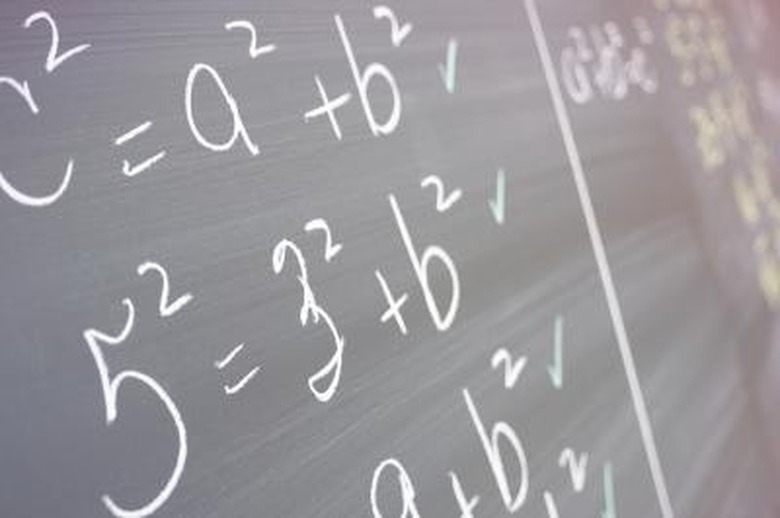How To Solve Algebraic Ratios
Ratios compare two numbers or amounts by division. Ratios often look like fractions, but they are read differently. For example, 3/4 is read as "3 to 4." Sometimes, you will see ratios written with a colon, as in 3:4. Read on to find out how to solve algebraic ratio problems using two methods: equivalent ratios and cross-multiplication.
Using Equivalent Ratios
Step 1
When you first begin studying ratios, you will encounter equivalent ratio problems. The word equivalent means equal value. You have probably come across this term when you learned about fractions. Equivalent fractions are two fractions with the same value. For example, 1/2 and 4/8 are equivalent because they both have a value of 0.5. Equivalent ratios are very similar to equivalent fractions.
Step 2
Let's use the following problem as an example for solving equivalent ratio problems: 5/12 = 20/n. First, identify the set of terms with the variable. A variable is a letter or symbol that represents a number. In this case, the second set of terms–12 and n–has has the variable. Note that if we were talking about fractions, we could call the numbers in the second set "denominators." However, this term does not apply to ratios. We will be using the known value in this set (12) to determine the value of the variable (12).
Step 3
In order to determine the relationship between the second set of terms in our ratio, we must first determine the relationship between the values in the first set. This should be relatively easy because both values in this set are known: 5 and 20. Now, ask yourself, "How are these values related?" You should be able to multiply or divide one of the numbers by a whole number to come up with the second number. In this case, we know that 5 times 4 equals 20. This will be the key to solving the ratio.
Step 4
Once you have determined how the terms in one set are related, you can solve the ratio. To create an equivalent ratio, you must multiply or divide both terms in the ratio by the same whole number. (This is the same way we create equivalent fractions.) So, let's return to our problem of 5/12 = 20/n. We know that if we multiply 5 by 4, we will get 20. So, we need to also multiply 12 by 4 to find the value of n. Since 12 times 4 is 48, n equals 48.
Using Cross-Multiplication
Step 1
When you have moved into more advanced studies of ratios, you will begin to encounter proportions. Proportions are statements that show two ratios as equivalent. Obviously, proportions are very similar to equivalent ratio problems. However, the method for solving these problems is different. Often, the values in proportions don't lend themselves to the technique outlined above. Let's use this problem as an example: 7/m = 2/4. Since we can't multiply 2 by a whole number to get a product of 7, we will not be able to solve this problem using the equivalent ratio technique. Instead, we will cross-multiply.
Step 2
To solve the proportion, we will begin by identifying cross products. Cross products are the terms situated diagonally from each other when the ratios are written vertically. Imagine placing an "X" over the proportion. The "X" will connect diagonal terms, which will be multiplied. In our problem, the cross products are 7 and 4, and m and 2.
Step 3
Once the cross products have been identified, use cross-multiplication to write an equation. This simply means writing the two cross products as multiplied terms with an equal sign between them. For the problem above, our equation is 7x4 = 2xm.
Step 4
Now that we have an equation, we can set about solving the proportion. First, simplify the side of the equation with two known values. In this case, we can simplify 7 times 4 as 28. Our equation is now 28 = 2xm.
Step 5
Finally, use inverse operations to solve for m. Inverse operations are opposites; addition and subtraction are opposites, and multiplication and division are opposites. Since our equation uses multiplication, we will use the inverse operation–division–to solve. Our goal is to isolate the variable, or to get it alone on one side of the equal sign. So, we will divide both sides of our equation by 2. Doing this cancels the "2x" with the m. Since 28 divided by 2 is 14, our final answer is m equals 14.
TL;DR (Too Long; Didn't Read)
After solving algebra problems, it's always a good idea to check your work. To do this, substitute your solution for the variable in the original problem. Does your answer make sense? If not, you may have made a procedural or calculation error along the way.
Cite This Article
MLA
Contributor, . "How To Solve Algebraic Ratios" sciencing.com, https://www.sciencing.com/solve-algebraic-ratios-4465306/. 24 April 2017.
APA
Contributor, . (2017, April 24). How To Solve Algebraic Ratios. sciencing.com. Retrieved from https://www.sciencing.com/solve-algebraic-ratios-4465306/
Chicago
Contributor, . How To Solve Algebraic Ratios last modified August 30, 2022. https://www.sciencing.com/solve-algebraic-ratios-4465306/
